#south florida water management district
Explore tagged Tumblr posts
Text
Valentine's Day Discharge Announcement
Yesterday, on Valentine’s Day, the estuaries did not receive sweet news. The U.S. Army Corps of Engineers, Jacksonville District, working to manage water together with their local sponsor, the South Florida Water Management District, announced that they will begin significant discharges (1800+/- cfs) from Lake Okeechobee (16.37 ft.) beginning Saturday, 2-17-24. The aerials below taken by my…

View On WordPress
#2508#announced that they will begin significant discharges#Ed Lippisch aerials February 2024#Empty SFWMD governing board seat#Jacksonville district#punishment#the South Florida Water Management District#The U.S. Army Corps of Engineers#Valentine&039;s Day Discharge Announcement#working to manage water together with their local sponsor
0 notes
Text

@traveling-spartan @priveetru
gonna be responding to this in a separate post because i've already left two comments on the post this was in reply to and i suspect that the OP already would consider that two too many.
at any rate:
Government regulation causes monopolies more often than it combats them.
[...]
It's why big corps like Disney lobby for said regulation in the first place, it crushes all their smaller competitors for them.
for what it's worth the data doesn't seem to be backing this up. if both these claims were true, you'd expect to see a multitude of pieces of regulation that disney supported, and few if any pieces of regulation that disney opposed, but this quick overview of some of disney world's political spending on florida trend [x] doesn't show that. now admittedly this is just the partial info for the disney world division in florida specifically, and not a general overview of all their political spending, so if anyone has more complete data i'd be interested to hear it. that said, i think it's a decent slice of data to start with.
in fairness, here we can find one notable example of disney lobbying for regulation- namely when they funded efforts to support Amendment 3, which would have prevented any more large casino chains from opening in florida, so that disney world could avoid competing with major casino chains like Genting and Las Vegas Sands. and, to be fair, as noted in the article this was a pretty major driver of campaign spending.
however, A: this was primarily aimed at combating rival megacorps, not combating small businesses, (and naturally the casino megacorps disney was fighting were spending their lobbying money to combat said regulation) and B: this was the only time in the article we see disney fighting for regulation rather than against. examples in the article of disney lobbying against regulation include:
By virtue of its size and economic importance, Disney has always been an influential voice in state politics. But the company had found itself on the losing end in a series of lobbying battles — among them, a fight with the National Rifle Association about whether employees could bring guns to work.
this is an important example of how regulation of private enterprise is sometimes necessary to preserve our fundamental rights- if disney can say employees can't bring guns to work even if they keep them in their parked car, what's to stop landlords from saying tenets can't bring guns in their apartment? if you value the right to bear arms, you should understand why sometimes the power of private enterprise over employees and customers must sometimes be curbed.
Disney also battled with personal-injury attorneys about whether parents could sign away the liability rights of their children and with counties and hotel chains about how online travel companies should be taxed.
[...]
Disney’s 2018 spending included $1 million on Amendment 2, which keeps a tax cap in place that limits increases in the taxable value of commercial and other non-homestead property from rising more than 10% per year. Records show Disney was by far the largest donor to a Florida Chamber of Commerce-backed political committee used to promote the amendment. The cap saved Disney more than $6 million last year alone through reduced property tax payments to Orange County and the South Florida Water Management District.
[...]
As prominent as Disney has made itself on the campaign trail, lawmakers who have worked with the company say it still tries hard to maintain a low profile while lobbying — to avoid having its brand linked with potentially controversial public policies. Disney, for example, has exerted “significant influence” on the Legislature to not pass a law requiring employers to use the e-Verify system to ensure they aren’t employing undocumented workers, says former Senate President Don Gaetz, a Republican from Okaloosa County.
[...]
Cloaked or not, the company enjoyed a number of successes in the 2019 legislative session. Late in the session, as lawmakers finalized a broad tax package, Disney — working through the Florida Retail Federation — persuaded lawmakers to add an extra sales-tax break that will help big retailers who order too much inventory and wind up not selling it all. Retailers generally don’t have to pay sales tax when they order inventory because they are planning to resell it to consumers. The sale to consumers is the transaction that’s supposed to be taxed. But retailers must pay the tax on whatever they don’t sell, since they have become the end user of the product. Disney has for years donated its leftover inventory to charities. So the company persuaded the Legislature to create a sales tax exemption for the leftover inventory that goes to charity. Economists expect the new tax break will save retailers about $5 million a year. Disney won’t say how much it expects to save itself. Disney also worked quietly to reshape a bill, which it objected to in 2018, that would have exposed hotel operators to civil lawsuits if they failed to do enough to prevent human trafficking.
i'll leave it for the reader to consider why disney would want to combat regulation which might cause them to be held accountable for facilitating human trafficking.
Disney even won some changes in state rules for how tourist venues manage all the stuff — from hats to strollers to phones — that visitors lose or leave behind. Generally, businesses are supposed to alert law enforcement and must hold on to lost property for 90 days before they can dispose of it. But that has become cumbersome for Disney — and for Universal Orlando, Central Florida’s other big theme-park resort — which must devote lots of warehouse space simply to holding lost-and-found items. Disney helped write a bill establishing new rules for theme parks, hotels and some other commercial venues that requires them to hold the property for just 30 days and then donate it directly to charity.
looking outside the article to other examples of disney's political lobbying, we find them lobbying against minimum wage laws [x]
Five years ago, on Nov. 6, 2018, the city’s voters approved Measure L, which mandated that “area resort workers” — Disneyland employees, basically — must be paid a living wage if the parent company receives city subsidies. The Walt Disney Company, which at the time was paying some of its workers the state-mandated $11 an hour minimum, fought the measure bitterly, and the ordinance spent most of the next five years kicking around the state court system as a class-action lawsuit sought to force the company to comply. Only in late October, when the California Supreme Court declined to hear Disney’s final appeal, did Measure L become settled city law.
we can also find disney lobbying against heat safety regulations (and against raises to the minimum wage at the same time, a twofer) [x]
House Bill 433 prohibits local governments from passing legislation that protects workers from extreme heat and laws requiring companies to raise the minimum wage beyond the state’s current $12 an hour. But now, we’re learning more about how this bill was passed and the role that Disney World played in helping to remove basic protections from outdoor workers, including cast members. According to Jason Garcia of Seeking Rents, the Florida Chamber of Commerce and Associated Industries of Florida donated more than $2 million to mostly Republican legislatures and another $1 million to the Florida Republican Party. The two lobbying groups expected House Bill 433 to become law for those donations.
[...]
Local government officials in South Florida were considering passing heat protections after the death of migrant farm workers of heat stroke. These laws would have prohibited work in extreme Florida heat and mandatory water breaks for workers. The possibility of these laws stopping work became dangerous to businesses in Florida, which would have had to shut down in extreme heat. Thus, donations to politicians were made to get this bill passed.
[...]
The law was wildly unpopular, with hundreds of civic groups opposing it. That outrage nearly killed the bill. However, according to Garcia, with just one day left in the legislative session, lobbyists sent texts to lawmakers to ensure the bill’s passage.
so what can we see from all this? first, that there are more pieces of regulation that large businesses lobby against than regulations that they lobby for, so the claim that businesses are the primary force behind pushing regulation is patently false and B: when businesses do support regulation in order to pursue their financial interests, this is mainly in order to combat rival large corporations, not small businesses. because fundamentally large businesses don't have to worry that much about competition from small businesses, because fundamentally small businesses can't compete. a small business would have had to expand to the point of being a large corporation long before it would be something disney would have to worry about "competing" with instead of just buying out or ignoring entirely. you think that a megacorp like disney is worried about competition from a little mom and pop shop? get real.
Fines for breaking the rules, for example, always disproportionately affect small businesses where large corporations either have enough money to pay those fines and be unaffected by them, or have the legal teams to get around them.
a few responses to this. the first is, so what? laws against murder, rape, assault, etc are all easier for the rich to dodge, and yet we don't decide murder should be legal. the solution to that imbalance is to be more serious about holding rich people accountable for these crimes, or for fine-related punishment to scale the fine to income, not to get rid of the laws altogether. if a regulation outlaws genuinely abusive or harmful behavior from a company, the way that small companies can avoid that fine is by simply not engaging in abusive or harmful behavior.
secondly, plenty of regulations nonetheless have specific exemptions for small businesses anyway. for example
In general, if your business is under $50 million in annual sales and your fuel or additive has traditional chemistry, then you are exempt from the health effects testing requirements. If you have non-traditional chemistry and are under $10 million in annual sales, you are exempt from some of the testing. EPA staff can discuss testing requirements.
[x]
or for another example:
The Federal Food, Drug, and Cosmetic Act requires packaged foods and dietary supplements to bear nutrition labeling unless they qualify for an exemption (A complete description of the requirements). One exemption, for low-volume products, applies if the person claiming the exemption employs fewer than an average of 100 full-time equivalent employees and fewer than 100,000 units of that product are sold in the United States in a 12-month period. To qualify for this exemption the person must file a notice annually with FDA. Note that low volume products that bear nutrition claims do not qualify for an exemption of this type. Another type of exemption applies to retailers with annual gross sales of not more than $500,000, or with annual gross sales of foods or dietary supplements to consumers of not more than $50,000. For these exemptions, a notice does not need to be filed with the Food and Drug Administration (FDA). On May 7, 2007, the Food and Drug Administration (FDA) launched a new web-based submission process for small businesses to file an annual notice of exemption from the nutrition labeling requirements. The new process will make it easier for businesses to update their information. In addition, firms eligible for the exemption will receive an electronic reminder when it is time to resubmit their nutrition labeling small business exemption notice.
[x]
or yet another:
Manufacturers of consumer products covered by the Department of Energy (DOE) standards with annual gross revenues not exceeding $8 million from all its operations, including the manufacture and sale of covered products, for the 12-month period preceding the date of application, may apply for a temporary exemption from all or part of an energy or water conservation standard. (42 U.S.C. 6295 (t))
[x]
so, no, regulations are not a sinister trick of large corporations to crush small business, because if they were they wouldn't specifically exempt small businesses.
does this mean that @priveetru was right? are regulations an important part of maintaining ideal market conditions and thus creating Real Capitalism, which is Good?
also no.
first, it's all "real capitalism". more regulated, less regulated, it's still Real Capitalism. and as demonstrated by the things going on around us, right now, real capitalism is Bad.
as @traveling-spartan pointed out, large corporations can simply afford to pay or dodge any fees for breaking regulation (though overall they would prefer not to have to, hence why they usually fight against regulation) and small businesses are often exempt from regulations in the first place. so who do regulations actually prevent from economic malfeasance?
nobody. not a soul. they're a completely ineffective bandaid on a bazooka wound which accomplishes nothing.
regulated or unregulated, all market economies tend towards consolidation. on a long enough timeline, all small businesses either are successful enough to become large businesses, are unsuccessful enough to go out of business, or are average enough to get bought out. it's an inevitable part of capitalism as it actually exists, and no matter what fantasy you chase after of a hypothetical, imaginary, impossible "real" capitalism, whether this fantasy is laissez-faire or tightly regulated, you will never escape that reality.
if you want to solve the problem, you can't keep chasing after an imaginary "real capitalism". instead you need to move past capitalism altogether. if you want to address the fact that bill gates and other billionaires are monopolizing farmland and therefore gaining control over our very subsistence, the solution to that isn't to sit around praying to the invisible hand of the free market to save us, and it's also not begging and pleading the existing bourgeoisie state to Le Heckin Tax The Billionaires. the real solution is for regular working class people like us to rise up and take back what is rightfully ours, and create a new state that actually serves the needs of the working people and not just the owning class.
14 notes
·
View notes
Text
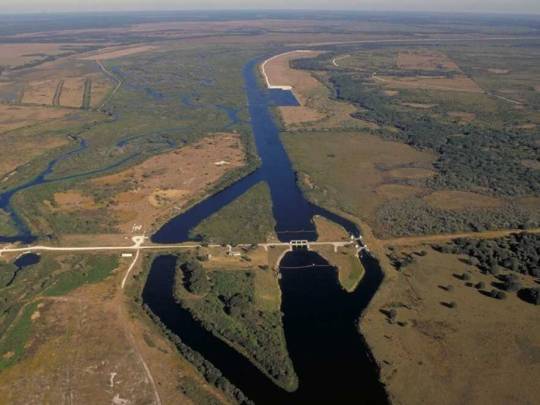
The Kissimmee River Restoration:
In the 1947, After vigorous flooding to outlying communities in Orlando and Kissimmee, residents demanded channelization and flood control measures be enacted, so the Army Corp of Engineers crafted a solution: a 103 mile long, 30 foot deep channelized canal of the Kissimmee River directly into Lake Okeechobee contained by massive adjacent berms. The flood control measures worked relatively well upstream however before the project even finished Floridians noticed an environmental catastrophy down river; a 90% loss in bird populations, heavy nitrogen and phosphorus loading, and destruction of important fish habitat.
So by the 1970s, congressional intervention funded scientists to start planning how to fix it. The end result was an economic split between the South Florida water management district and the Army Corp of engineers to split the cost of restoration project 50/50. In the 1990s the work of burying old channel (in certain segments) and the restoration of 43 miles of riverway and a 3 mile wide flood plain began (visible in the image below).

What I'm going to show you is my access to the ecological progress of the completed filling of the of the C-38 channel.
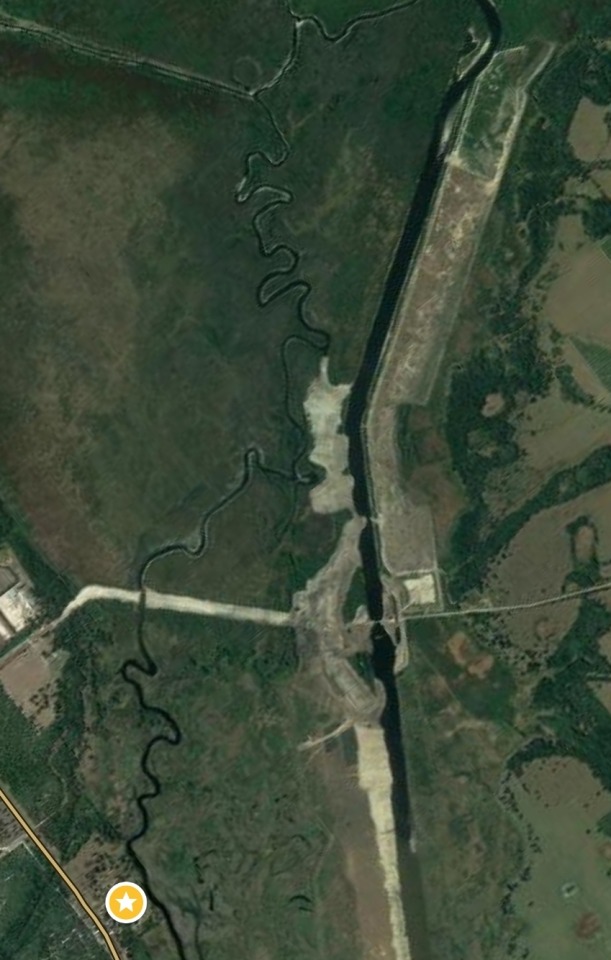
Visible in the satellite imagery from Google we can see the meandering channel of the historic Kissimmee riverway adjacent to a wide canal system and dam, up until 2 years ago most water flowed through the canal rather than the river. The natural canal functioned as a sort of oxbow lake surrounded by cow pasture. The Corp and the SFWMD sought to create a massive wetland floodplain habitat by filling the channel and restoring flow where it had once was gone. To do so they needed also needed to remove the lock/dam. The channel was filled with the adjacent berms, no new fill was required in these sections. The dam (first image) was a large water control system with a mining access road above it. As you can see below, the process of filling it left a lot of bare ground, there was no planting strategy prepared for the loose soils instead it was left to flood when the remaining channel was filled.
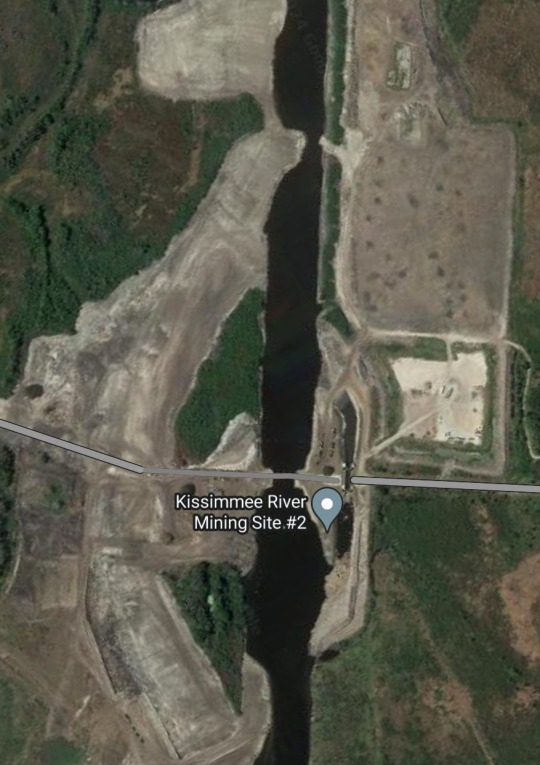
Here is the that dam and road today:
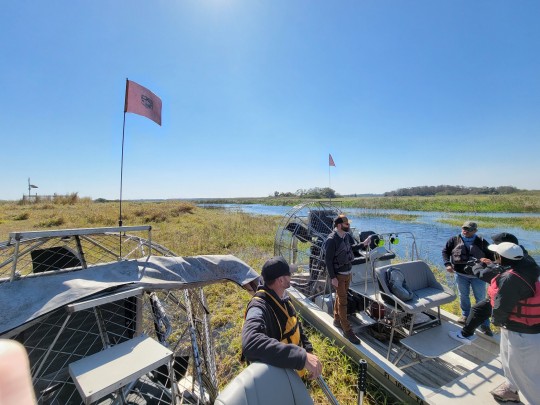
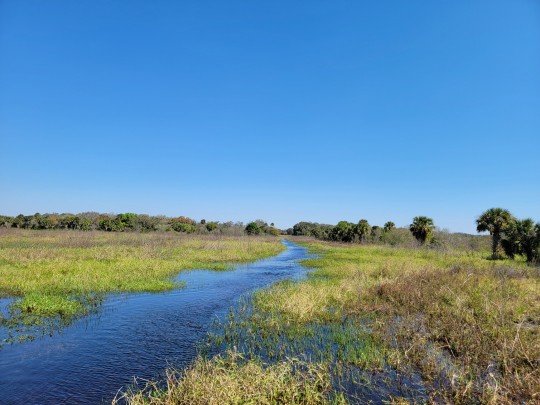
All that remains is an elevated mound which houses a deep aquifer well monitor and plants as far as the eye can see. Plant life took over immediately after flow restoration, I mentioned before no new plantings were done in these section (new plantings were only established in "cuts" across the old channel to prevent erosion) so all plants are spontaneous. Spontaneous vegetation includes both introduced and native species, our guides stated that their primary concern was providing bird and fish habitat, pesticide regimes are used to control some problematic invasives (how else can you manage 20,000 acres). You have to understand the image below is only 2 years of growth in an area which was previously debris and cow pasture, the water management district is delighted to see such a fast recovery of any kind.
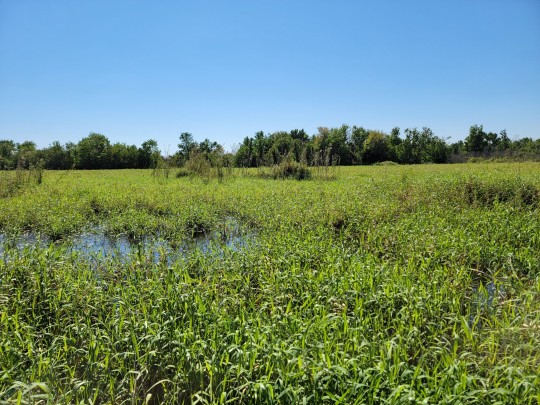
So what happened to the cow pasture?

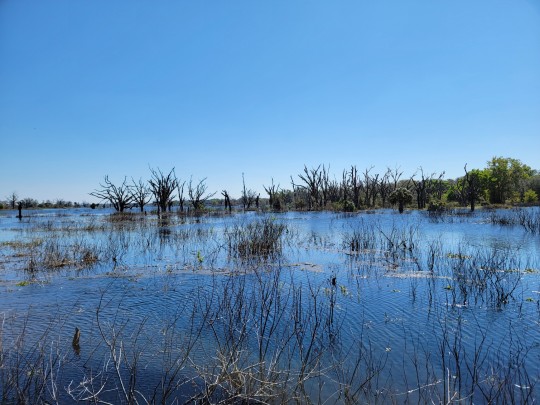
With floodplain restored, much of the habitat is being converted into an emergent wetland, which will be flooded around 6-9 months out of the year. This caused the death of much of the recent dryland species which faltered under the loss of their Terra-firma conditions. On the plus side this is providing bald cypress with beneficial growing conditions

All together the Kissimmee River restoration is no small feat and far from a complete restoration. The multi-billion dollar project is necessary to bring back an ecosystem on the verge of total collapse but also to reduce nutrient loading into Lake Okeechobee, as an experimental ground for other river restoration projects. This is by no means a complete restoration, much of the river is still channelized to protect local towns (and Orlando). Instead the restoration of flow is meant to provide beneficial habitat combined with storm water control.
Is this project a success? Who can say so far, all I know now is the beautiful sound of birds chirping in the morning air while floating in a vast wetland seemed like the beginning of something better.
Image 1 source: The South Florida Water Management District
#Kissimmee river#river restoration project#florida#ecological restoration#photographers on tumblr#this is a summary i dont have time to be extremely thorough#american south#kissimee river restoration
6 notes
·
View notes
Text
While driving in the swamplands some 40 miles west of Miami, Mike Kirkland noticed a log lying in the road ahead, so he and his colleague stepped out of their white GMC work truck. This was no log. “As we got closer, we realized it was a python,” he says. “It was so big, it looked like a fallen tree.” Kirkland asked the colleague to hang back, then crept to within five feet of the predator as it basked on the warm pavement.
“She saw me,” he says. “I’m 5'11". And she picked herself up and practically looked me in the eye.” The snake’s sheer size gave him pause—but not for long. She stretched open her mouth, revealing dozens of curved teeth as sharp as daggers, then launched her head at Kirkland. He dodged a couple of strikes before spotting an opening to grab the snake’s head. The nonvenomous 17-foot constrictor then tried to wrap herself around the sweating Kirkland, who slipped through coil after coil. About 20 minutes later, the exhausted snake gave in, and Kirkland euthanized the animal.
This is all in a day’s work for Kirkland, an invasive-animal biologist who manages the South Florida Water Management District’s Python Elimination Program. His team patrols roads like this one beside Big Cypress National Preserve looking for Burmese pythons, one of the world’s most unyielding invasive species. The team recently removed their 8,000th python.
Florida has a twisted relationship with the Burmese python. Americans imported nearly 100,000 of them from Southeast Asia between 1996 and 2006. (The US banned their import in 2012.) Many pet owners hadn’t realized that the snakes grow to 12 feet, on average, and they abandoned them. South Florida’s warm wetlands offer the perfect adoptive habitat. Their inconspicuous patterning conceals them in the already remote Everglades, which makes them hard to track. Ecologists peg their detectability at less than 1 percent. That means if there are 100 snakes in your survey area, you’d be lucky to spot just one.
The pythons officially established a self-sustaining population in the ecosystem in 2000, according to the US Geological Survey. Today, there are likely tens of thousands of them across South Florida, and the USGS believes the number will only increase as populations expand to new areas within the peninsula. (They’re not likely to spread to similar wetlands in Alabama and Louisiana, though, since they can’t survive the colder temperatures they’d have to migrate through to exit northern Florida.) According to the USGS report, eradication is “likely impossible.” And now, says Kirkland, “They are eating all of our native wildlife.”
Earlier this year, USGS scientists synthesized decades of research on python biology and potential control tools. They described 76 prey species found in the guts of pythons: mammals, birds, iguanas, and even alligators. “Our native wildlife is not used to a large snake predator of that size,” says Melissa Miller, an invasion ecologist with the University of Florida. “Something that large is not really on their radar.” Ecologists often describe an invasive predator’s prey as “naive,” since they haven’t co-evolved with the thing that now might kill them.
That has created a problem. Around 2010, soon after meeting this big, new predator that could outcompete and eat them, South Florida’s mammal populations collapsed. Large and medium-size mammals have been scarce for almost a decade, leaving mostly smaller mammals, like rodents.
Some ecologists thought the pythons would become victims of their own success. “They were supposedly out of food,” says Paul Taillie, a wildlife ecologist at the University of North Carolina at Chapel Hill. But Taillie’s research has shown that pythons just switched to eating the smaller mammals instead, causing those populations to drop too. In 2021, Taillie reported disappointing proof that mammals were not bouncing back. “There’s exceedingly little sign of any mammal activity” in South Florida, he says.
The only resistant species has turned out to be black rats—but they’re also invasive. Black rats arrived in the Americas from Europe centuries ago onboard the ships of explorers and colonizers. They’re resistant because they reproduce a lot and don’t compete with the pythons or large mammals for food: They can scavenge carcasses and eat plants, insects, and scraps from humans. This is the reason they thrive all over the world.
So can anything curb the python’s takeover? First, there are teams like Kirkland’s, which employ contractors to track and capture the snakes year-round. Every capture and kill follows ethics guidelines and federal laws about transporting illegal pets. “They need to be respected as the beautiful living creatures that they are,” Kirkland says. “They’re here through no fault of their own.”
And for six of the past 10 years, Florida has tried to educate the public about invasive species and the folly of keeping pythons as pets, thanks to the Florida Python Challenge, a 10-day event for amateur python hunters, in partnership with the state’s wildlife agency. Participants catch the snakes, which they euthanize. This year, at least 840 participants registered for a shot at $17,500 in prizes. The tally for this year’s hunt hasn’t been released yet, but each of the last two hunts yielded over 200 captures. “It really does a lot to educate the public,” Kirkland says, “to teach about the importance of why you shouldn’t allow an invasive exotic pet to get out.”
But scientists also want to know if the nonhuman denizens of the Everglades are pushing back against the python—specifically, to see if pythons have their own “prey naivete.” Could other species be preying on young pythons?
To answer this question, in 2020 and 2021 a team of USGS researchers implanted 2- to 3-foot-long pythons with radio transmitters and released them back into Big Cypress National Preserve. The transmitters tracked movements down to a 3-meter radius, and each transmitter had a “mortality sensor” that was triggered if the animal hadn’t moved in 24 hours.
Nineteen young pythons died during the study period. Team members waded into the swamp to find out exactly where and how. They snooped for every sign imaginable: paw prints, fur, bite marks, scrapes, and scat. Dead snakes and transmitters turned up in soil, in trees, and underwater. The team brought any carcasses they could find back to the lab for necroscopies. Twelve of the 19 cases had enough evidence to point to a killer, according to results published earlier this year in a study titled “Natives bite back.”
They had expected some deaths, but not as many as they found, says Amy Yackel Adams, a USGS ecologist on the team. “We were quite surprised,” she says, “especially by predation of native Florida species.”
Native alligators and cottonmouth snakes killed eight of the 12, and mammals killed four. One native cotton rat killed a python while being attacked. That rat was actually larger than the young snake, making it a risky meal. (The team couldn’t say which mammals killed the other three pythons, but they’ve noted bobcats and coyotes in the area. It’s possible that these species or others, like birds, killed the other seven snakes—but the researchers couldn’t find enough evidence to rule out other possibilities, like starvation.)
“It’s always nice to see native species getting the upper hand with Burmese pythons, as it’s often not the case,” Miller says. She’s experienced alligators and crocodiles killing pythons—and a 15-foot python eating a 6-foot gator. (Miller contributed to the USGS review, but not the “Natives bite back” study. Her lab measures each snake from the Florida Python Challenge in an impartial judging role.)
It’s not surprising that native animals would begin pushing back, says Taillie, who was not involved in either USGS study: “Prey populations of invasive species will start to respond over time and adjust their behaviors.” There are a few historical examples. On the Spanish Cíes islands, for example, native birds called shags shifted their nests to sites less vulnerable to invasive minks. In Australia, native snakes evolved resistance to the toxins of invasive cane toads, and ate fewer toads. Analogous adaptations could be happening here, according to Taillie.
But, he continues, “I would be surprised if there was enough of that to decrease the population of pythons in any significant way.”
“If they’re recognizing this invasive [species] as a food source, that’s a glimmer of hope,” agrees Adams. “That will be a piece of the puzzle, a very tiny sliver of management for maintaining healthy native species. But that alone doesn’t even come close.”
Animal dynamics won’t eradicate pythons on their own, but Taillie says neither will state hunting programs, which are at the mercy of taxpayer funding. Plus, he says, “Finding a python in the Everglades is like finding a needle in the haystack. And it’s a really large haystack. You only need a couple to survive, and then they can bounce back.”
“It’s not realistic that we’re going to get rid of all of them,” Kirkland agrees. But with the right technology, he thinks they can drive python numbers down enough that native animals will return: “The technology is updating itself every day. We’re trying to stay on the cutting edge of that.”
One of those methods is tagging pythons and tracking them to learn about their habits and to find other pythons. Miller’s team has tagged the snakes during the breeding season, when multiple males congregate around a female. “If you tag a male, he can lead you to where these breeding events are happening. And then you can remove all the snakes,” she says.
Others now tag pythons’ prey, like rabbits, raccoons, and opossums. When the snakes swallow the prey, they swallow the tag. It’s then easier to study or euthanize them. University of Florida researchers also tried putting rabbits in snake-proof cages in the Everglades to lure pythons closer to remote cameras. Nine rabbit pens lured 22 pythons over 90 days, and each stayed in the area for over an hour on average, according to a state report. “It sounds like a simple idea—and it is—but it’s also brilliant. It’s another way to get at these hidden pythons that we probably wouldn’t otherwise have found,” Kirkland says. Combining rabbit scents and remote traps might yield the same results.
Another idea referenced by the USGS paper pairs near-infrared cameras with an algorithm trained to detect the Burmese python’s unique markings. The system would display the snake onscreen as a bright white object that could be tracked in real time. Kirkland’s team has been involved in early testing, and he envisions equipping trucks and drones to find the most well-hidden invaders. “That’s still being dialed in. but it shows some promise,” he says.
USGS scientists are also wondering if gene-editing technology could help. Scientists could modify female snakes to only birth male offspring. After many years, the dearth of reproductive females would bottleneck the population. (Researchers have previously released genetically engineered mosquitoes in Florida to produce a similar population crash.) USGS scientists are exploring the feasibility of this idea, but concrete plans are still far off.
So for now, the state mostly relies on patrols like Kirkland’s. After his bout with the 17-footer back in 2018, Kirkland hauled the dead snake away in the back of his GMC, affectionately named Python 1. Five years later, he now cruises the wetlands in a new truck, Python 2. The mammals still haven’t returned. The snakes still haven’t left. But he speaks with a confidence you’d expect from a guy who grabs giant snakes by the head. “I’ve got about 20 years until I retire, and I’m really optimistic that we’re going to be in a better place by then,” he says. “But these things take time.”
3 notes
·
View notes
Text
Drivers of Submerged Aquatic Vegetation in Florida Springs
Florida’s springs are home to manatees, mermaids…and submerged aquatic vegetation, commonly known as “SAV”. The term “SAV” includes freshwater submerged vegetation like Vallisneria americana (“eelgrass”) and filamentous algae. In this presentation, attendees will learn about recently completed studies by the District that analyzed trends and drivers of change in SAV communities within our springs. Presented by by Madison Trowbridge, Ph.D., Springs Scientist, Southwest Florida Water Management District. This is the Monthly Meeting and Public Program of the Hernando Chapter, Florida Native Plant Society. Arrive at the South Brooksville Community Center at 6:30 pm for snacks and socializing; the formal meeting and program starts at 7:00 pm. The South Brooksville Community Center is located at 601 E Dr Martin Luther King Jr Blvd, Brooksville, FL 34601. Contact us at [email protected] Read the full article
0 notes
Text
Logistics Transportation in Miami

The city of Miami, Florida, which is well-known for its stunning beaches and lively nightlife, has also emerged as a dominant force in the field of freight forwarding and logistics services. As a result of its advantageous position and cutting-edge infrastructure, Miami has emerged as a significant hub for commercial transactions involving the United States of America, Latin America, and the Caribbean. The factors for Miami's thriving freight and logistics business, as well as the influence that industry has had on the local economy, will be investigated in this article.
For Logistics Transportation in Miami - Visit Here
1. Location that is Strategic- logistics services and freight forwarding
The strategic position of Miami is one of the key reasons for the city's success in the freight and logistics business. Miami, which is located at the intersection of North and South America, acts as a gateway for trade between the two continents because of its location. Because of its closeness to major shipping lanes and its access to major highways and rail networks, it is a great site for businesses that want to transport their goods in a rapid and effective manner.
The Port of Miami- logistics management and logistics transportation
Port Miami, which is frequently referred to as the "Cruise Capital of the World," is not only a significant tourist attraction but also an essential component of the freight and logistics business in Miami. Due to the fact that it processes a significant amount of cargo on an annual basis, the port is considered to be one of the busiest ports in the United States with better facilities for logistics management and logistics transportation. Port Miami is able to accept huge ships and handle a broad variety of cargo, including containerized products, autos, and perishable commodities, thanks to its deep-water channels and facilities that remain up to date-with the latest technological advancements.
Role of the International Airport of Miami- A blessing for a logistics company
Miami, in addition to having a seaport, is also home to an international airport that is of world-class quality. Because of the substantial volume of air cargo that it processes, Miami International Airport (MIA) is a vital link in the supply chain that spans the whole industry. As a result of its large cargo facilities, which include refrigeration capabilities for perishable items, MIA is an appealing option for businesses that want to convey products that are time-sensitive. Because of its great access to major roads and rail networks, as well as its close proximity to the central business district of Miami, the airport is a good option for freight forwarding since it is both efficient and convenient.
Connectivity and the Facilities They Provide
The city of Miami's outstanding infrastructure and connections have been of considerable assistance to the city's freight and logistics business. In order to guarantee that commodities are transported in an effective manner, the city has made significant investments in the modernization of its road, rail, and telecommunications networks. While the enormous roadway network makes it possible to easily access key markets in the United States, the train network makes it possible to link to other regions of Florida and even further afield. Additionally, the excellent telecommunications infrastructure that Miami possesses guarantees that communication is uninterrupted and that goods can be tracked in real time by the logistics company.
Zones of Free Trade
The city of Miami is home to a number of free trade zones (FTZs), which contribute to the city's growing appeal as a logistical infrastructure center. Businesses are able to take advantage of a variety of benefits offered by FTZs, including duty exemptions and expedited customs processes. Companies are able to store, process, and distribute goods in these zones without having to pay any customs charges until the products are sold on the local market. Companies who are interested in international commerce have found Miami to be an advantageous location as a result of this benefit.
The city of Miami's freight and logistics business is well-positioned to experience sustained expansion in the years to come. It is anticipated that Miami will see an increase in the amount of cargo it handles as a result of the enlargement of the Panama Canal, which will allow larger ships to pass through. Additionally, the city's dedication to innovation and technology, as well as its investments in infrastructure, will further boost the city's competitiveness in the global logistics industry.
Bottom Line
The thriving freight and logistics business in Miami is a credit to the city's strategic position, world-class infrastructure, and commitment to innovation, as stated in the conclusion. Miami has developed into an essential link in the global supply chain as a result of its thriving ports, international airports, and vast transportation networks. The expansion of the business has not only resulted in the creation of employment and brought in cash, but it has also established Miami as a logistical hub for worldwide commerce. It is a source of great pride for Fulfillment Hub USA to be a part of the flourishing freight and logistics business in Miami, considering the company's dedication to both excellence and efficiency.
Contact Us at: Website: www.axislogisticservices.com Contact us link: https://www.axislogisticservices.com/contact/ Address: 16295 NW 13th Ave bay c-2, Miami, FL 33169 Email: [email protected] Phone: 3057534011
0 notes
Text
University Colloquium Water Crisis Blog Part 2 of 3
There are many different non-profit organizations with varying perspectives and plans of action for combatting the water crisis. Some approach the issue from a health or water quality perspective. For example, “Charity: Water” is focused on helping people get access to clean water and the non-profit “Water is Life” makes and distributes portable water filters that look like big straws containing components that eliminate harmful bacteria and viruses while reducing the presence of other harmful particles so people can drink safely wherever they go. Meanwhile, the “Planet Water Foundation” is a nonprofit that installs water filtration systems called Aqua Towers in rural communities and at schools around the world so they can have clean, safe drinking water. Some communities and locations have physical or geographic access to clean, safe drinking water, but residents don’t have financial access to the water, so other organizations take a financial approach. On the consumer end, “The Human Utility” is a non-profit organization that is striving to help low-income families get assistance paying for their water bills so their taps won’t be turned off by utilities. On the provider end, “Valor Water” helps utilities understand who is wasting water and who is conserving it among its customer base. With the collected data, they can then target rate hikes at water hogs, and cut conservationists a good deal. This would also have the benefit of incentivizing responsible water use. Technology provides some non-profits with the means to explore other fronts against the water crisis. TOTO makes better, more efficient toilets, and was recognized by the U.S. Environmental Protection Agency for their efforts. Pluto.ai performs data collection that assists in the early detection of potential infrastructure failures to help maintain low operating costs.Some local actions that are being taken in my community are being headed by a diverse set of facilitators. The state government under the leadership of Governor DeSantis is focusing on 29 key projects aimed at Everglades restoration, as well as improving and maintaining water quality in Florida. Completing these projects is vital to the South Florida Water Management District’s mission of protecting South Florida’s communities from flooding and safeguarding and restoring local water resources and ecosystems. Academic institutions have also gotten involved, as evidenced by the participation of the University of Florida and Universities in the Tampa area in the installation of a bio-infiltration system at Aaran’s Pond in Tampa’s University Area Community, where more than one in three residents live below the federal poverty level. This effort was funded by a three-year, $1.5 million grant from the U.S. Environmental Protection Agency.
0 notes
Text
Jobs Out West - BRSWSF - Belvedere Road and Sansbury Way - SW Corner - South Florida Water Management - August 3, 2023
The South Florida Water Management District Office is located on the SW Corner of Belvedere Road and Sansbury Way. NW Corner of Belvedere Road and Sansbury Way Index: Notes: Blue letters indicate linked to the website. Black indicates no website. Alston’s Embroidery – Embroidery Shop – 561-373-4333 Art Family Dentistry – Dentist – 561-660-8101 Citrus Contracting – Roofing Contractor –…

View On WordPress
0 notes
Text
Deep in Florida, an ‘Ecological Disaster’ Has Been Reversed—and Wildlife is Thriving
Much of Florida’s Kissimmee River has been restored to its natural state, a milestone worth celebrating—and learning from.
— Photographs By Carlton Ward Jr. | April 6, 2023

The Kissimmee’s meandering floodplains teemed with life before they were diverted into a straight canal a half century ago. A recently completed project has restored the curves—seen here—and replenished the wetlands. The waterfowl, raptors, fish, and mammals are returning. By Douglas Main
If you’ve been to Disney World in Orlando, you’ve been to the Northern Everglades. Much of the water within the famous “river of grass” originates in Central Florida and flows south via the Kissimmee River—one of the more important and lesser-known waterways nationwide.
Sixty years ago, the Kissimmee meandered for more than 100 miles from the Kissimmee Chain of Lakes to Lake Okeechobee, and its floodplains were home to seasonal wetlands rich with life. But in the 1940s, in response to flooding and hurricanes, the state asked the federal government to help build a sprawling network of canals and waterways to drain the land.
The Army Corps of Engineers complied and, beginning in the 1960s, turned the meandering Kissimmee into a 30-foot-deep, channelized canal. Within a few years, populations of waterfowl dropped by 90 percent, bald eagle numbers by 70 percent, and some fish, bird, and mammal species vanished. The channel acted like a pipe, moving water quickly off the landscape to Lake Okeechobee, and then to the ocean. While that helped prevent some flooding in the short term, it robbed the stream of oxygen, which decimated the fish community and gave nutrient pollution no time to settle and be absorbed by the wetlands.
The disrupted hydrology and ecological problems were so glaring that, beginning in the 1990s, the Army Corps and a variety of state, federal, and local partners cooperated to undo the damage. More than 20 years later, at a cost of over $1 billion, the physical restoration of the river is now complete: 40 square miles of wetlands have been reestablished and rehydrated.
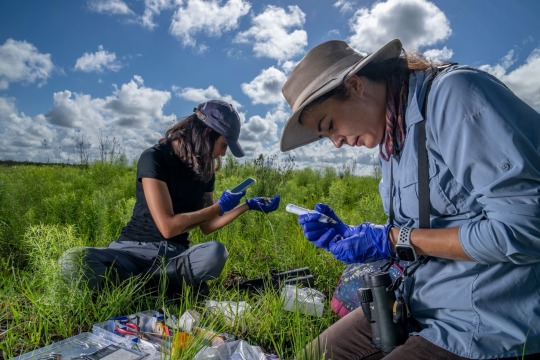
Researchers Fabiola Baeza-Tarin (right) and Nicole Rita (left) place bands on Florida grasshopper sparrows, one of the most endangered bird species in North America. These creatures are making a comeback in the prairies surrounding the Kissimmee River.
Already the biological impact of the project has become clear. As the wetlands have come back, so have the birds. “That response was immediate and pretty impressive,” says Lawrence Glenn, director of water resources with the South Florida Water Management District.
‘Triumph of Imagination’
In all, nearly half of the river has been restored to its original state. The project involved filling in 22 miles of the canal, re-carving sections of the old river, and restoring 44 miles of the waterway’s natural meandering paths, according to the Army Corps.
“It's a triumph of imagination [and] of partnership between the federal government and the state” and other organizations coming together, says Shannon Estenoz, assistant secretary for fish and wildlife and parks with the Department of Interior, who formerly worked for several different environmental organizations in Florida.

Populations of popular game fish, such as bass, have climbed, in part because the water is more oxygenated and invertebrates that demand such conditions, such as mayfly and caddisfly larvae, have returned. Populations of wading and waterbirds are already above intended targets; some species that disappeared during the days of the canal—including ibis, bitterns, avocets, and sandpipers—are back.
The restoration is a grand success story that “shows it’s possible to act at the landscape scale, and [it] demonstrates how quickly ecosystems can recover,” Estenoz adds. And it’s vitally important for water quality and the threatened species that live there, including limpkins, snail kites, and bald eagles, says Congressman Darren Soto, whose district abuts the river.
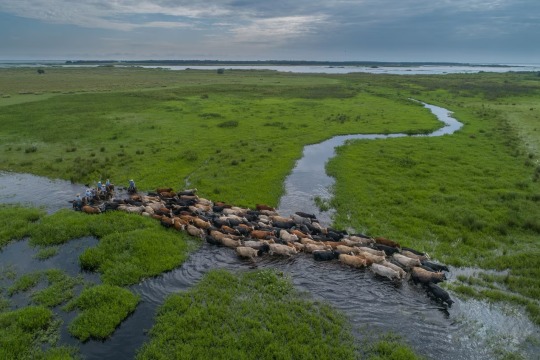
Riders on horseback move cattle across Otter Slough on the Lightsey Ranch with Lake Kissimmee in the background. The Lightsey family has protected more than 90 percent of their land in conservation easements, helping steer development away from sensitive areas in the Everglades Headwaters and Kissimmee River Valley. First receiving cattle and horses from the Spanish in 1521, Florida has the longest history of cattle ranching in the United States.
The Kissimmee will become part of the National Wild and Scenic Rivers System, thanks to an act sponsored by Soto and signed into law as a part of the 2023 Consolidated Appropriations Act. The designation entails special protections and future funding for conservation work.
On the Water
To see the fruits of the restoration myself, I take a late summer ride down the river with photographer and National Geographic Explorer Carlton Ward, Jr., and Adam Bass, vice president of Conservation Florida. The first stretch of the river, directly south of Lake Kissimmee, consists of the old canal—300 feet wide and 30 feet deep, straight as a runway, with almost no birds or wildlife to mention. This part was left as a canal in part to prevent flooding in the Orlando area.
Passing through a lock to get the restored part of the river, the difference is stark and obvious as the river begins its natural flow. The abrupt edges are replaced by thickets and grasses and sabal palms and oaks—and we start seeing birds: herons, egrets, limpkins, and more. Surveys show that there are 50 species of fish in the Kissimmee, nearly 70 species of wetland-dependent birds, over 20 types of reptiles and amphibians, and four mammals that only live in the rehydrated marshes.
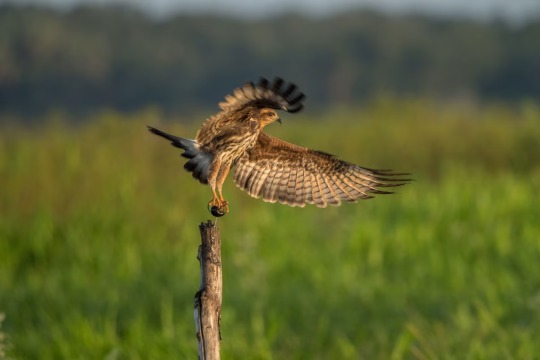
Snail kites are medium-sized hawks that feed on mollusks. They are considered an endangered species in Florida, the northern end of their range. The Kissimmee and its surrounding wetlands are an important habitat for them.
It's the rainy season and the wetlands are flooded, partially submerging vast fields of grasses and flowers. We pass dozens of alligators and bass fishermen. Though we are in crowded South Florida, there are long stretches where we see no people and hear only the sounds of frogs and waterbirds. This is still a wilderness. The river wiggles and bends and sometimes braids, leaving multiple pathways to choose from.
The next morning we wake before dawn and head out. As light creeps over the water nearly 10 snail kites—a subtropical species that’s considered endangered in the United States—fly overhead, many with apple snails in their beaks, large mollusks nearly the size of my fist.
These medium-sized hawks have striking red eyes and hooked beaks; the males are an almost bluish gray, with cream-and-slate undertails, the females a mottled chestnut and white.
Near the town of Lorida, we pull off at the Istokpoga Canal Boat Ramp—one of the only direct ways to access the restored part of the river, and meet Paul Gray, science coordinator with Audubon Florida. He also explains how the restoration project adds 100,000 acre-feet of water storage, which helps prevent flooding, and slows much of the water down, allowing nutrients to settle out.
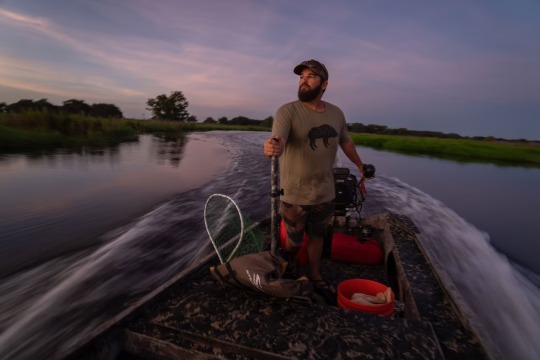
Adam Bass, with Conservation Florida, steers his mud boat through a restored section of the Kissimmee River. With 1,000 people moving to Florida each day and land rapidly being developed, conservationists are working to protect land surrounding the Kissimmee and in the Florida Wildlife Corridor for the benefit of people and wildlife.
One night, we make camp along the river, serenaded by tree frogs and katydids—and watch fireflies flash in an open field, mirrored by twinkles of lightning in a brooding storm cloud on the horizon. Camping in Florida in August is not for the faint of heart, though, as a self-regenerating swarm of mosquitos appears at dusk—the likes of which I’ve never experienced.
Back to the Future
When the channelization was completed in the 1970s, everybody realized it was a mistake. Locals had been against it from the beginning, explains Monrad Chandler, a longtime resident of the area, because “a lot of people used to make a living on the river.”
We’re sitting on a parcel of land he owns right next to the Kissimmee. His son-in-law, Matt Pearce, ranches on this land, where he practices rotational grazing—cattle are currently excluded from this area, allowing the plants to recover and grow back.
“When they channelized the river, there was no marsh no more … then no ducks, no snipe, [no] wading birds,” he says. “A lot of people had to change their livelihood.”
“It was an ecological disaster,” Gray agrees.
But now, those birds are coming back—and the restored section looks essentially the way it used to, Chandler says, fondly recalling hunting and fishing on the river as a youngster.
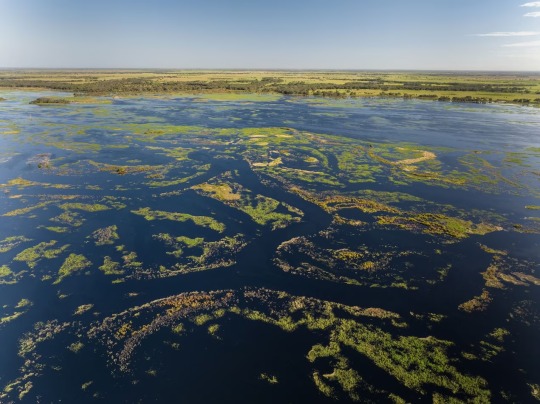
The Kissimmee River and surrounding wetlands flooded after Hurricane Ian. This helped to prevent property damage in developed areas. “The Northern Everglades’ biggest challenge is water storage,” says Paul Gray, science coordinator with Audubon Florida, and these rehydrated wetlands help take excess water.
These restored wetlands provide corridors for larger wildlife such as Florida panthers and bears and habitat for endangered species, including grasshopper sparrows. By storing water, they also help prevent flooding during storms.
“The Kissimmee River accomplished an amazing feat last summer when Hurricane Ian slammed Florida,” Ward says. “It filled to the 100-year flood level and did its job naturally absorbing billions of gallons of water, with no loss of property, because of the restoration efforts.”
Yet there’s still much work to be done. About half of the Kissimmee consists of a canal, and there’s a big backlog of hydrological and research projects. One vital and imminent project involves raising the water level in Lake Kissimmee—and thus increasing water storage.
Gray explains that various areas of Florida—including Orlando—are running out of easily accessible water, draining the state’s aquifers. “These water projects are going to become more and more important for the future of Florida,” Gray says.
“This project is going to be saving water, going to be slowing it down—not only is that a benefit to wildlife, but to water management, and our ability to meet [our] water needs.”
1 note
·
View note
Text
Concerns-Overfull WCAs & Lake O Discharges
Yesterday, I listened to the South Florida Water Management District’s Governing Board meeting via Zoom. The overriding issue, besides the fact the St. Lucie River system’s C-44 Reservoir is not working, Lake O is over 16 feet and discharges could soon be imminent, was “high water in the Water Conservation Areas.” What are WCAs anyway? They were built as part of the giant drainage system of…

View On WordPress
#Concerns-Overfull WCAs & Lake O Discharges#Deer high water#Discharges Lake O#Drowning the Animals#High Water worries WCA3#mercy killing 1982#Polluting Ourselves#Water Conservation Area 3#WCA3
0 notes
Text
Absentee Proprietor Providers
If you're a seasonal or everlasting Jupiter resident, you already know it's Florida’s playground. Snowbirds flock to its sunny shores for its vibrant scenery and friendly palm beach home management parks. Whether you’re away at work or play, you'll need to know that your property is taken care of.
At the very least licensed individuals should have a business tax receipt registered within the county where they work. Look for extra endorsements similar to accreditation with organizations such as the Better Business Bureau (BBB). Vacation householders might swap horror tales over a BBQ and snort it off on reflection seasonal home management palm beach, however you really are not wanting for any surprise visitors taking advantage of your vacant home. Taylor’s background resonated with Palm Beach client and lawyer Richard Emory, who discovered of the company while perusing the Internet for such providers.
Go to the beach the place the delicate sand and calm waters are perfect for sunning, swimming, volleyball or long romantic walks. Experience history with a go to to the Baynard Cove Ruins and the Indian Shell Ring. Get active with horseback riding at Lawton Stables, or go biking, kayaking, boating and fishing. Located on South Forest Beach on Hilton Head, the home is in a really private residential space affordable home management palm beach. Located within a 5 minute stroll to considered one of Hilton Head Island’s famed beaches, this elegant home features two spacious residing areas and BRAND NEW and totally renovated kitchen. New kitchen includes a large capability separate ice maker, two ovens, further large and deep sink and a convection oven.
The inexpensive cost of building and funcionality makes these homes nice for vacation rental or for full time residing. Vacation rental property may be particularly worthwhile in quickly growing areas, such as Rosemary Beach, Florida, and other cities in the vacation home management palm beach southeast. Not only do these properties enjoy year-round demand for renters, but growing native populations cause these properties to understand at a fee well above the nationwide average. I&S Property Management Inc. is a full service management company.
You have peace of thoughts that our service will watch and alert you in case of emergency, maximizing the value and safety of your own home funding. We have a vast listing of testimonials from joyful shoppers which have used our providers private home management palm beach and are happy to come home and relax! As a premier home watch and property management company for all of South Florida. We will be positive that your home in Palm Beach County, Martin County, and Broward County, Florida will keep the way in which you need it.
Kenco Property Management specializes within the care and safety of second homes/vacation properties and absentee homeowners. We offer varied home-watch companies such as regular home inspections and residential upkeep when you are away. We are operators seeking to broaden with the best snowbird home management palm beach franchisees in the right markets. Our shops open and ramp up rapidly, and the cash-on-cash returns in our company are unparalleled. We present most assist for each franchisee, from site choice to accounting, advertising, training, customer service support, business to business improvement and more!
During eviction proceedings in front of a district courtroom judge, Caliber had agreed to sell back the home to the resident at double the market value. Caliber stored sending eviction notices but would not return the man's calls, although he was making an attempt to repurchase the house with the assistance of a mortgage from a nonprofit group home management palm beach. "The kids go without new toys. They like ice cream however that is now a luxurious. We should sacrifice lots of their fundamental requirements so we are able to pay the lease." The LoopNet service and knowledge supplied therein, whereas believed to be accurate, are provided "as is".
0 notes
Text
Everglades wading birds have a banner nesting season, thanks to heavy rainfall
New Post has been published on https://petn.ws/lFkWo
Everglades wading birds have a banner nesting season, thanks to heavy rainfall

Late wet season rainfall and a tropical storm in 2021 produced a banner year for Everglades wading birds, according to the latest tally by the South Florida Water Management District. Across the expansive marshes, from water conservation areas in Palm Beach, Broward and Miami-Dade counties, to Everglades National Park, the number of nests counted in […]
See full article at https://petn.ws/lFkWo #BirdNews
0 notes
Text
Key Neighborhood & Youngster Safety Payments Head To House Flooring
South Florida's premier vacation spot for purchasing, dining, white ... Lauderdale's Intercoastal Waterways, that includes a few of the most highly sought-after water views and proximity to the most desirable leisure destinations. Our property management professionals consistently drive NOI whereas providing a really superior residential experience. To actually appreciate your new hometown’s place in history, find an house near Albuquerque’s historic Old Town district, where many homes are on the National Register of Historic Places. There’s stay weekend entertainment all through the summer in Old Town Plaza, and some of the city’s greatest buying too.
Most affordable neighborhood in Albuquerque is Near North Valley with a median home itemizing worth of $190,000. We attempt to set the usual for our trade and encourage others by elevating the bar on providing homes for sale in albuquerque nm exceptional real property funding alternatives in U.S. progress markets. We may help you succeed by minimizing threat and maximizing profitability.
You can begin out on a strolling trail in Sandia Heights and hike up into the mountains for a day, or camp out for the evening. The Sandia Peak Ski Area, located in the Cibola National Forest, has thirty trails for skiing and snowboarding. The well-known Sandia Peak Tramway, the world’s second-longest tramway, stays in use even after the snow is gone, taking sightseers on scenic chairlifts. If you benefit from the nightlife, exhibits homes for sale in albuquerque new mexico, and casino motion, you’ll love residing in shut proximity to the Sandia Resort and Casino. If residing in stunning Sandia Heights isn’t enjoyable enough, you possibly can spend a day within the resort’s spa. The Sandia Heights neighborhood, developed in 1965, is constructed on 1600 acres within the foothills of the Sandia Mountains.
Here is the Albuquerque real property worth appreciation graph by Zillow for the past decade. Bernalillo County is positioned in central New Mexico and is home to Albuquerque, a big economic and cultural crossroads in the American Southwest. The average sale price per square foot in Albuquerque is $190, up 20.3% since final year. Brokerage new home builders in albuquerques offered by TPH ZeroDown Brokerage, Inc. in CA, TPH ZeroDown Brokerage TX LLC in TX, and TPH ZeroDown Brokerage LLC in all different states. Use our price of living calculators to evaluate how a lot you’ll must earn to reside comfortably in key cities. Welcome to Placitas, New Mexico, located between Santa Fe and Albuquerque.
There were no accidents, however the attacks provided a violent reminder that the false claims a couple of stolen election persist in posing a danger to public officials and democratic establishments. One invoice would defend election officials, from the secretary of state to county and municipal elections clerks, from intimidation — outlined as inducing or attempting to induce fear. New Mexico Secretary of State Maggie Toulouse Oliver last new homes for sale albuquerque yr reported threats towards her to the FBI and went into hiding beforehand, whereas county clerks have reported threats and harassment in current times. We, my wife and I, just completed a home transform for our daughter and an addition to our home. We supply custom orders for skylights, inside doors, exterior doorways, home windows and more!
This peaceable new home neighborhood offers easy access to your favorite adventures. New Phase - Discover beautiful home craftsmanship and family-friendly amenities at Mountain Hawk Estates in Rio Rancho. Redfin is redefining real property and the house shopping for process in Albuquerque with industry-leading know-how, full-service brokers, and decrease fees that provide a better value for Redfin consumers and sellers. Most homes for sale in Albuquerque keep on the market for forty nine days and obtain 1 provides.
Perspective home purchaser names will be chosen at random by a Certified Accounting Firm at a later date. Perspective buyers might be contacted in order to settle for or decline an appointment with RayLee Homes. All appointments will be held at the RayLee Homes Main Office positioned at 4131 Barbara Loop SE in Rio Rancho, NM. This location will allow for design finishes to be proven and chosen.
Regular workplace hours will proceed on Thursday, March 2 from 1-5 p.m. ABQnews Seeker Even after Gov. Michelle Lujan Grisham ... Even after Gov. Michelle Lujan Grisham issued an government order revamping New Mexico's youngster welfare company, lawmakers are moving forward with a variety ...
Albuquerque International Sunport is served by eight main airlines and four regional airways offering nonstop service to over 20 main cities including Chicago, New York, Dallas, and Atlanta. Prior to the pandemic, job progress in Albuquerque reached a ten year excessive, in accordance with the City of Albuquerque . The median value per square foot of Condos/Townhomes in Albuquerque, NM was 179 in May 2022, in comparison new homes albuquerque with 176 in 2021. The median record price of Condos/Townhomes in Albuquerque, NM was $238,000 in May 2022, compared to $263,000 in 2021. High Desert has a median itemizing home price of $612K, making it the most costly neighborhood in Albuquerque. Homes for sale in Albuquerque have a median itemizing worth of $325,000.
0 notes
Text
Prescribed Fires Scheduled In Hernando and Pasco Counties

Setting prescribed fires in controlled settings can reduce the risk of wildfires burning out of control. That’s why the Southwest Florida Water Management District (District) will be conducting prescribed burns now through September on Annutteliga Hammock, the Weekiwachee Preserve, Starkey Wilderness Preserve, Conner Preserve, and Cypress Creek Preserve. Annutteliga Hammock is located east of U.S. Highway 19, north of Centralia Road, and south of the county line. Approximately 200 acres will be burned in small, manageable units. Conner Preserve is located south of State Road 52 and west of Ehren Cutoff. Approximately 700 acres will be burned in small, manageable units. Cypress Creek Preserve is located east of Ehren Cutoff, one mile south of State Road 52. Approximately 300 acres will be burned in small, manageable units. Starkey Wilderness Preserve is located east of New Port Richey, west of the Suncoast Parkway, north of State Road 54 and south of State Road 52. Approximately 700 acres will be burned in small, manageable units. The Weekiwachee Preserve is located west of U.S. Highway 19 between Spring Hill and Hernando Beach. Approximately 200 acres will be burned in small, manageable units. Some trails may be temporarily closed during prescribed burn events. SWFWMD Aims to Reduce Risk of Wildfires by Scheduling Prescribed Fires for Hernando and Pasco County Properties Some major benefits of prescribed fire include: - Reducing overgrown plants, which decreases the risk of catastrophic wildfires. - Promoting the growth of new, diverse plants. - Maintaining the character and condition of wildlife habitat. - Maintaining access for public recreation. The District conducts prescribed fires on approximately 30,000 acres each year. You can click here to see aerial footage from a prescribed fire in the Green Swamp Wilderness Preserve where District land management staff burned 320 acres. Read the full article
0 notes
Video
youtube
Cheryl's Kitchen Potato Boats - Restaurant Review - Fair Play, South Car...
We decided to try a local restaurant near our campground in Fair Play, South Carolina, for carryout! It is called Cheryl's Kitchen Potato Boats... interesting name, right? How did we like the food? Watch our review to find out! Address: 272 Herring Rd, Fair Play, SC 29643 We make these videos primarily for our own pleasure, and hope that you enjoy them as much as we do making them! Please don't forget to Subscribe, Like, Comment, and Share! ▶︎Would you like to help support our projects? Even small amounts help! We use this money to purchase new equipment (we are currently in desperate need of a new computer for editing and a cellular booster). Thank you for your generosity! https://www.paypal.me/ourcrazyrvlife ▶︎ WHO WE ARE We are the Nichters, and this is Our Crazy RV Life! We sold everything we could, and gave away the rest, just so we could live in a 28' RV travel trailer with our dog, Bailey. You see, we had a dream. We wanted to be free of the "normal" expectations that most Americans have. You know, that so-called American dream of owning a beautiful home on a cul de sac, going on expensive vacations once a year, and otherwise living to work. We wanted to turn that into living in a home on wheels, being able to pick up and go whenever we wanted, and working to live life the way we want. This way, we can plan on Jeff retiring in just a couple of years instead of working until he can't physically do it anymore. Come along with us as we immerse ourselves in Our Crazy RV Life! ▶︎ SOCIAL MEDIA LINKS http://www.Instagram.com/OurCrazyRVLife http://www.Facebook.com/OurCrazyRVLife http://www.Twitter.com/rv_our https://www.rvillage.com/profile/OurCrazyRVLife ▶︎ MEMBERSHIPS AND PRODUCTS WE LOVE Harvest Hosts 15% OFF Membership http://harvesthosts.refr.cc/ourcrazyrvlife Boondockers Welcome http://www.boondockerswelcome.com/referrals/32389/ Thousand Trails Get out and camp with $100 off a Thousand Trails Camping Pass. Start exploring by clicking this link! https://mbsy.co/LWWlG SW Florida Water Management District https://www.swfwmd.state.fl.us/ ▶︎ Our Crazy RV Life, All Rights Reserved *This channel is for entertainment purposes only. We are not RV experts and are not making recommendations. We share our opinions and what works for us, but you should do your own research and make your own decisions.
0 notes
Link
The head of the state agency overseeing the multi-billion-dollar Everglades restoration project said this week he will no longer let his employees cooperate with the top scientists who are supposed to be advising the project.
South Florida Water Management District executive director Pete Antonacci declared at a public meeting Thursday that his agency will no longer work with the National Academies of Science — one of the nation's premier scientific organizations — because science advisers there won't "tend to their knitting."
The headline erases the casual sexism that is in this official document.
#Florida politics#Everglades#environment#National Academies of Science#South Florida Water Management District#FloriDUH
1 note
·
View note